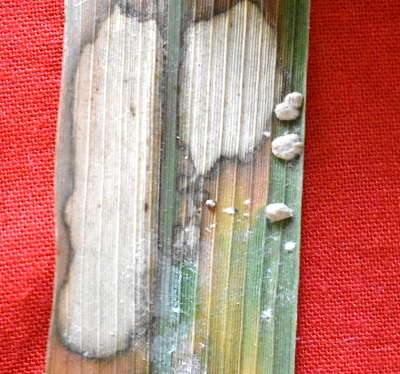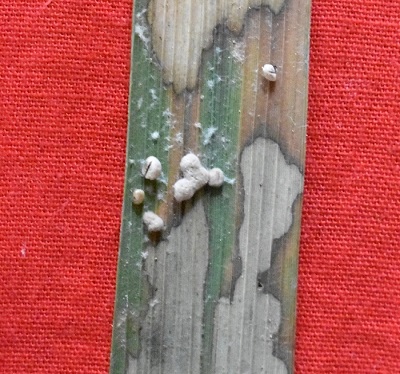Rice Sheath Blight / ‘SNAKE -SKIN’ disease
Sheath Blight: Rice Sheath Blight (SB) is one of the most devastating disease of rice worldwide and can cause upto 50% yield loss under optimal conditions. The tragedy is that, ‘there is no naturally occurring fully resistant rice variety to Sheath Blight available’ and farmers have to solely rely on fungicides to manage it.
Other names: Snake skin disease, Oriental Leaf, Sheath Blight, Pellicularia Sheath Blight, Sclerotial blight and Banded blight of rice.
Causative organism: Rhizoctonia solani AG1I-A (Fungus)
Symptoms: Spherical /oval/ ellipsoid shaped lesions (0.5–3 cm), with green grey to straw coloured centre and a wide reddish brown margin starting from the sheath of leaves at the water line and gradually progress from leaf sheath to leaf blades, panicles and tillers. Gradually, leading to lodging and hamper in grain filling. Near maturity of the plants dark brown coloured sclerotia are produced superficially on or near the lesions and easily fell down on soil.
Image Gallery:
 View
View |
 View
View |
 View
View |
 View
View |
 View
View |
 View
View |
Plant growth stage: The infections start at late tillering to joint elongation stage and becomes severe at panicle differentiation.
Favorable conditions:
- Warm temperature (28-32°C), High humidity (~95%).
- Use of Nitrogen fertilizers.
- Canopy (microclimate) formation with semi-dwarf rice varieties.
Pathogen survival: The pathogen is soil-waterborne and can survive as sclerotia (survival structures made of hyphae with stored food inside) for 2-3 years and reinfect rice plants in the subsequent planting. Dormant sclerotia floats on irrigation water travelling long distances leading to greater spread.
Entry to the host: The pathogen can penetrate the plant by lobate appressoria (stomatal entry) or infection cushions (cuticular penetration). Both sclerotia and mycelia can serve as the inoculum (See Image Gallery Figure 5 and Figure 6).
About the pathogen:
Kingdom: Fungi
Subkingdom: Dikarya
Phylum: Basidiomycota
Class: Agaricomycetes
Order: Cantharellales
Family: Ceratobasidiaceae
Genus: Rhizoctonia
Species: Rhizoctonia solani
Rhizoctonia solani (R. solani) is a multi-host pathogen and infects over 27 families of plants causing root, crown, hypocotyl, pod and belly rot, sheath and leaf blight, banded leaf, brown patch and canker. R. solani is divided into 14 anastomosis groups (AG1-AG13, AGB1) based on compatibility for hyphae fusion. Further AG1 has been subdivided into IA, IB and IC based on DNA sequence similarity. R. solani AG1-IA causes Sheath Blight disease in rice.
Disease cycle:The fungus survives as sclerotia under unfavorable conditions and an remain viable for 2-3 years. Upon onset of favorable environmental conditions, they reinfect the rice plant by taking entry through cuticle or stomata (See Figure 7).

Figure 7: Disease cycle of rice Sheath Blight
Management: See this page
Host resistance: See this page